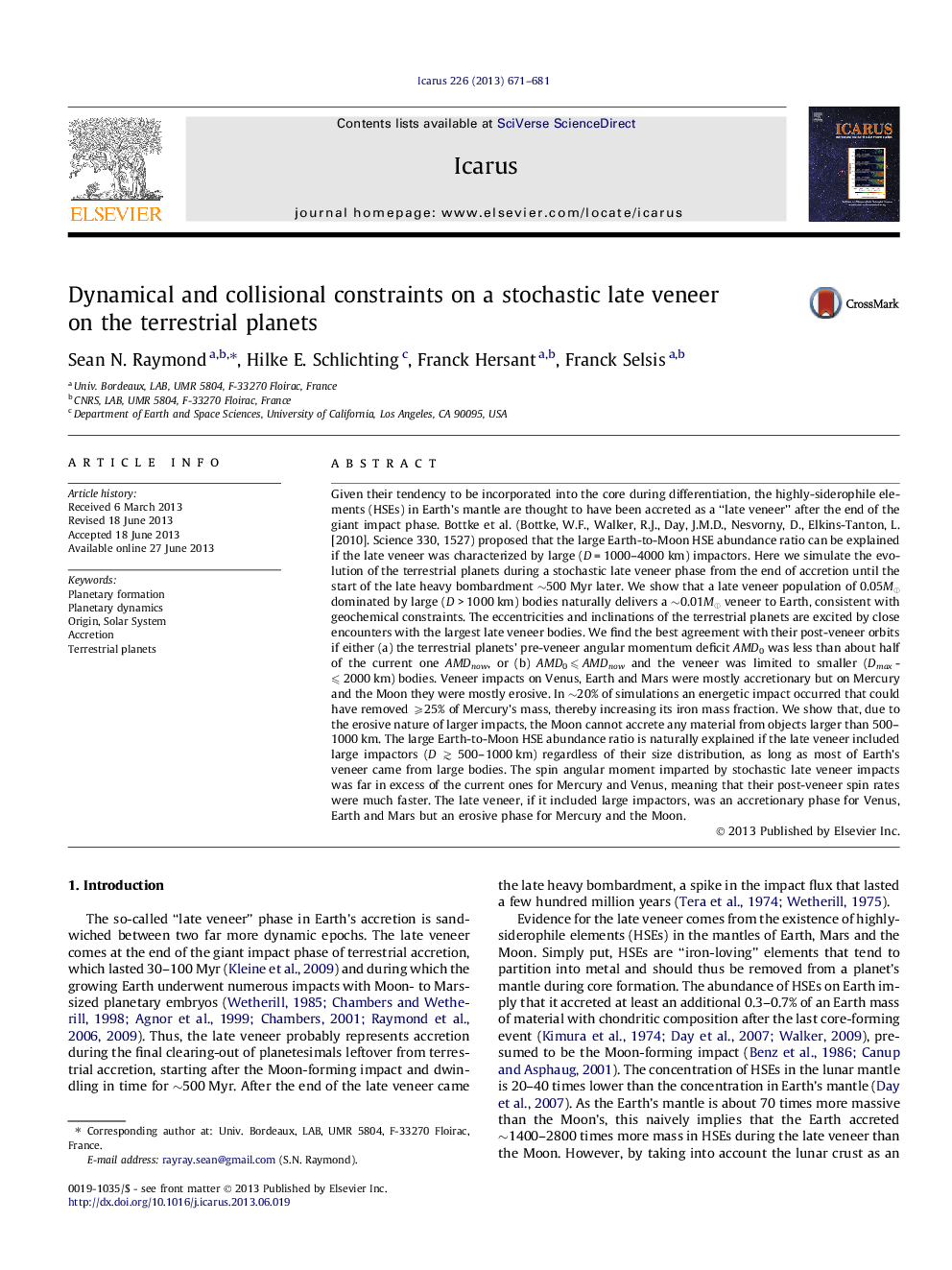| کد مقاله | کد نشریه | سال انتشار | مقاله انگلیسی | نسخه تمام متن |
|---|---|---|---|---|
| 10701333 | 1021128 | 2013 | 11 صفحه PDF | دانلود رایگان |
عنوان انگلیسی مقاله ISI
Dynamical and collisional constraints on a stochastic late veneer on the terrestrial planets
ترجمه فارسی عنوان
محدودیت های دینامیکی و برخوردی بر روی یک روکش دایمی تصادفی بر روی سیارات زمینی
دانلود مقاله + سفارش ترجمه
دانلود مقاله ISI انگلیسی
رایگان برای ایرانیان
کلمات کلیدی
شکل گیری سیاره، دینامیک سیاره ای، منبع، سیستم خورشیدی، صعود سیارات زمینی،
موضوعات مرتبط
مهندسی و علوم پایه
علوم زمین و سیارات
علوم فضا و نجوم
چکیده انگلیسی
Given their tendency to be incorporated into the core during differentiation, the highly-siderophile elements (HSEs) in Earth's mantle are thought to have been accreted as a “late veneer” after the end of the giant impact phase. Bottke et al. (Bottke, W.F., Walker, R.J., Day, J.M.D., Nesvorny, D., Elkins-Tanton, L. [2010]. Science 330, 1527) proposed that the large Earth-to-Moon HSE abundance ratio can be explained if the late veneer was characterized by large (D = 1000-4000 km) impactors. Here we simulate the evolution of the terrestrial planets during a stochastic late veneer phase from the end of accretion until the start of the late heavy bombardment â¼500 Myr later. We show that a late veneer population of 0.05Mâ dominated by large (D > 1000 km) bodies naturally delivers a â¼0.01Mâ veneer to Earth, consistent with geochemical constraints. The eccentricities and inclinations of the terrestrial planets are excited by close encounters with the largest late veneer bodies. We find the best agreement with their post-veneer orbits if either (a) the terrestrial planets' pre-veneer angular momentum deficit AMD0 was less than about half of the current one AMDnow, or (b) AMD0 ⩽ AMDnow and the veneer was limited to smaller (Dmax ⩽ 2000 km) bodies. Veneer impacts on Venus, Earth and Mars were mostly accretionary but on Mercury and the Moon they were mostly erosive. In â¼20% of simulations an energetic impact occurred that could have removed ⩾25% of Mercury's mass, thereby increasing its iron mass fraction. We show that, due to the erosive nature of larger impacts, the Moon cannot accrete any material from objects larger than 500-1000 km. The large Earth-to-Moon HSE abundance ratio is naturally explained if the late veneer included large impactors (D â³Â 500-1000 km) regardless of their size distribution, as long as most of Earth's veneer came from large bodies. The spin angular moment imparted by stochastic late veneer impacts was far in excess of the current ones for Mercury and Venus, meaning that their post-veneer spin rates were much faster. The late veneer, if it included large impactors, was an accretionary phase for Venus, Earth and Mars but an erosive phase for Mercury and the Moon.
ناشر
Database: Elsevier - ScienceDirect (ساینس دایرکت)
Journal: Icarus - Volume 226, Issue 1, SeptemberâOctober 2013, Pages 671-681
Journal: Icarus - Volume 226, Issue 1, SeptemberâOctober 2013, Pages 671-681
نویسندگان
Sean N. Raymond, Hilke E. Schlichting, Franck Hersant, Franck Selsis,
